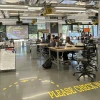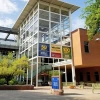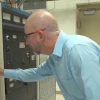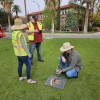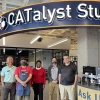Discovering the Unique Technologies Behind Arizona Athletics
A discovery series on the diversity and uniqueness of technology services at UArizona

Photo courtesy of Arizona Athletics
As you walk into Arizona stadium anticipating the evening’s match-up, you feel the excitement of the fans and look around to see bright lights, dozens of digital screens with videos, photos, graphics drawing you into the Arizona fan experience. When kickoff happens, fans’ focus moves to the action. But have you ever wondered about the technology behind the Arizona fan experience?
I asked Jeff Kohler, Associate Athletic Director, IT and HR Integration, about the technologies he and his Arizona Athletics IT team support. In his role, Jeff oversees the IT team, a web team, and the creative services team, and the creative service team oversees broadcasting.
It is quickly apparent that what sets this IT team apart is the large number of live events they support. They exercise masterful skill in integrating an array of technologies into the production of live action sports. This includes coordinating with national broadcast entities, local advertising partners, University and Athletics staff, students and coaches, and let’s not forget about the fans! Everyone uses technology to participate in the Arizona Athletics experience.
“We have a space that is dedicated to making sure that the fans are being entertained and having a good time. A lot of that work gets supported by our internal IT team. For example, inside of the venue control room there's a computer that generates graphics and puts up a score on the inside the arena that fans will see. But our IT team is also responsible for the computer where an operator enters stats or information on the players,” Jeff explains.
Millions of dollars of Arizona Athletics’ revenue comes from media rights distributions and various other fees paid through advertising partners that are tied to the tech that the IT team supports on game day. It’s all built around technologies that must run smoothly as it is critical to the specifically timed digital choreography happening. It’s a huge responsibility.
There have been some stressful moments when, for example, commentators are live on air, but the stat laptop they're reading from isn't working. The team is responsible for troubleshooting and getting that laptop working or fixing the network connection to that device. Joel Holowell, Systems Administrator, Senior, provides an added layer of support when emergencies happen. Added stress comes from knowing it's all live where one doesn’t get to push the pause button because the tech is not working correctly.
Arizona Athletics has 22 sports programs at the university, many that overlap seasons, as in football and basketball, where the team supports the technology simultaneously in different venues. There is no time of the academic year where only one sport is competing.
Game Day Setup
Football is the sport that has the most moving parts. Jeff confesses it is the sport that places the biggest burden on his staff. With upwards of 50K fans inside the stadium, he and his team start the day 8 to 10 hours before game time.
At the beginning of the football season, Arizona Athletics hosted a kick-off concert as part of the fan experience on the Mall among tailgaters. Aaron Varner, Technical Director, spends months coordinating audio and technical needs for the guest bands to facilitate a successful show for all to engage in.
At the beginning of game day, all the video surfaces are turned on and verified to be projecting the right content. Ryan Bloom, Director, IT Projects, and his team test all the broadcast equipment and makes sure the inhouse cable TV distribution system is running.
Athletics has a partnership with Cox Communications for most of the channels and a commercial license. The control room drives all the LED surfaces in the stadium—anywhere there is digital advertisement, stats, captioning and video streaming.
In that same timeframe, Mike Patton, Program Manager, Event Technology, and his team confirm that the audio setup that was tested during the previous week is still functioning as expected. They dial in the audio levels on the field and through the arena, adjusting for any feedback shared from the marketing team from the prior week. This starts about 6 hours before the game and requires them to test all equipment that will be used, including referee microphones, handheld microphones, audio speakers, etc. They do this to ensure that communication to the fans throughout the event is as clear as possible, and that the emergency egress announcements will work in the event they are necessary.
After verifying the digital displays and audio systems, Andrew Deighan, Manager, IT Services, typically checks in with the ticket office to make sure they haven't had any issues with their point-of-sale (POS) terminals. They need to be able to process credit cards. The POS system is closely tied into the ticketing system where tickets are sold onsite and online and the data is stored to a cloud-based server.
“The wifi access points at all the entry gates connect to Android handheld devices. These devices check against the database in real time to make sure that the ticket scanned is a valid ticket.” Jeff explains that the gate wifi access points (APs) are specific to that use only. They have a restricted SSID used by the handheld devices that is the only SSID on those APs to prevent UA wifi from overloading it. Andrew and his team of student workers take responsibility for gate entry support as it is a critical point for limiting only ticketed patrons into the facility. As Arizona home football games are one of the largest gatherings of people in Tucson, Athletics staff coordinate with local law enforcement to sweep the stadium prior to every home game to ensure there is no unauthorized access and the facility is secure.
Communications
Because of the strain of wifi service at a full Arizona Stadium, Arizona Athletics IT is also responsible for coordinating the distributed antenna system with cellular providers. “We have a neutral site host the University contracted with several years ago. Their agreement is that they will build out all that equipment for us.” Vendors such as Verizon, AT&T and T-Mobile all have space that supports event attendees. The team uses their mobile phones to test the cell signals before each event as they are a critical safety element for anyone needing 9-1-1 dialing access.
A more recent technology Arizona Athletics has implemented is a robust security camera system that can be shared with UAPD on game day. The IT team is responsible for more than 80 cameras that cover the perimeter of McKale Center and the football stadium.
Event staff can view any of the cameras on their mobile phone to monitor an evolving situation. The cameras also provide additional services such as counting people entering at the gates. They can indicate hotspots where unusual numbers of people are gathering beyond the normal traffic, and when people are gathered in a space they shouldn’t be in after hours. While the camera system implementation was driven by Athletics game day support needs, the ease of access has made this a tool that is used in various UAPD investigations for incidents that occur near Athletics facilities on a daily basis. The camera system has helped meet campus safety needs and made Arizona Athletics a safe campus partner.
Media connectivity is also a big job on game day, from a TV broadcasting truck parked at the dock to designated writers and radio broadcasters in the press box on the fourth floor of the stadium.
“We have a couple of network access points set up for media designed to support their game day operations. Because we're not allowed to just let anyone on our network without knowing who they are, we document who is in each space in case there was ever a security incident. We try to remove as much friction as we can for media so they can do their job. But we also realize that we need to be accountable to what's going on our network and try to find a good balance.”
The players and coaches also rely on the IT team for infrastructure and support of technologies such as digital signage to coordinate when the team is supposed to leave the locker room, what their schedule is, or where they're supposed to be on game day. “They have digital time clocks in the locker rooms and other electronic equipment that is tied into the main timing system. Internal screens with student athlete videos and their workout equipment are also tied into the technology.”
Once the game kicks off, the Arizona Athletics IT team gets some relief. Mike Lowery, Web Manager, performs one of the last tasks for the evening by setting up for the postgame press conference. He begins testing microphones and cameras at half-time to ensure the streaming equipment will be ready for live stream of the post-game press conference for the fans.
The end of the night is sometimes quite late as all the technology has to be carefully tucked away for the next time.
Preparing for the Big 12
As part of his management duties, Jeff is currently reviewing the contractual agreement changes that are coming with the move to the Big 12 Conference.
Anyone who attends Arizona Athletics events will recognize there has been infrastructure in place to support television entities who produce many of the broadcasts that happen inside of UArizona facilities. Starting this fall however, there will be about 50 events that go directly up onto ESPN+ and will need to be produced from the Athletics facility.
Jeff explains, “We're working through how we must adjust our technology to meet that additional robust broadcast capacity. ESPN has stringent requirements around live broadcast production, so we are going to have to set up a primary control room to be able to support ESPN+ quality broadcast.”
With the Conference change, it now becomes the responsibility of the University to put those events on air in the quality of broadcast that ESPN+ requires. “It's pretty stressful, and right now, we're working through getting our new media rights agreement understood and learning what our technology expectations are for the upcoming year.”
Next time you find yourself at one of the many Arizona Athletics events, look around and be amazed by the technology that helps make it such an exciting fan experience. It couldn’t happen without a great team of people making the technology work.




